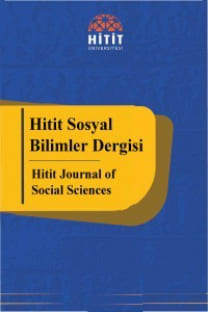KADIN ÇALIŞANLARIN TOPLUMSAL CİNSİYET ALGILARI VE İŞE ADANMIŞLIKLARI ARASINDAKİ İLİŞKİ
Kadın Çalışanlar, İşe Adanmışlık, Toplumsal Cinsiyet Algısı
THE RELATIONSHIP BETWEEN SOCIAL GENDER PERCEPTIONS AND FEMALE EMPLOYEE COMMITMENT
Woman Employees, Work Engagement, Social Gender Perceiveness,
___
- Bailey, C., Madden, A., Alfes, K., & Fletcher, L. (2017). The meaning, antecedents and outcomes of employee engagement: A narrative synthesis. International Journal of Management Reviews, 19(1), 31-53.Barnes, D., & E. Collier, J. (2013). Investigating work engagement in the service environment. Journal of Services Marketing, 27(6), 485-499.Bicchieri, C. (2014). Norms, conventions, and the power of expectations. Philosophy of Social Science: A New Introduction, 208-229.Bicchieri, C., & Chavez, A. (2010). Behaving as expected: Public information and fairness norms. Journal of Behavioral Decision Making, 23(2), 161-178. Chen, J. V., Yen, D. C., Rajkumar, T. M., & Tomochko, N. A. (2011). The antecedent factors on trust and commitment in supply chain relationships. Computer Standards & Interfaces, 33(3), 262-270.Cogin, J. A., & Fish, A. (2009). An empirical investigation of sexual harassment and work engagement: Surprising differences between men and women. Journal of Management & Organization, 15(1), 47-61.Del Líbano, M., Llorens, S., Salanova, M., & Schaufeli, W. B. (2012). About the dark and bright sides of self-efficacy: Workaholism and work engagement. The Spanish Journal of Psychology, 15(2), 688-701.Fiske, S. T. (1998). Stereotyping, prejudice, and discrimination. In Gilbert, D. T., Fiske, S. T., and Lindzey, G. (Eds.), Handbook of social psychology (4th ed., Vol. 2, pp. 357-411). New York: McGraw-Hill.Gallup (2012). Gallup Engagement Index. (http://eu.gallup.com/berlin /118645/gallup-engagement-index.aspx, 13.04.2017 tarihinde erişildi).Gilbert, D. T., Fiske, S. T. & Lindzey, G. (Eds.) (1998) Handbook of social psychology (4th ed.). New York: McGraw-Hill.Hochschild, A. (1983). The managed heart: Commercialization of human feeling, by Arlie Russell Hochschild. Berkeley, CA: University of California Press.Kahn, W. A. (1990). Psychological conditions of personal engagement and disengagement at work, Academy of Management Journal, 33(4): 692-724.Karatepe, O.M. (2012). Job resources,work engagement, and hotel employee outcomes: a time-lagged analysis, Economic Research, 25, 1127-1140.Mendes, F. & Stander, M.W. (2011). Positive organisation: The role of leader behaviour in work engagement and retention, South African Journal of Industrial Psychology, 37 (1), 1-13.Rees, C., Alfes, K. & Gatenby, M. (2013). Employee voice and engagement: connections and consequences, International Journal of Human Resource Management, 24, 2780-2798.Rosch, E. (1978). Principles of Categorization. In Rosch, E. and Lloyd, B. (Eds), Cognition and categorization (pp. 27-48). Hillsdale, NJ: Lawrence Erlbaum.Rothbard, N.P. (2001). Enriching or Depleting? The Dynamics of Engagement in Work and Family Roles, Administrative Science Quarterly, 46, 655-84.Xanthopoulou, D., Bakker, A.B., Demerouti, E. & Schaufeli, W.B. (2009). Reciprocal relationships between job resources, personal resources, and work engagement, Journal of Vocational Behavior, 74, 235–244.Wong,C.A.,Laschinger, S. & Cummings, G. G. (2010). Authentic Leadership and Nurses' Voice Behaviour and Perceptions of Care Quality, Journal of Nursing Management, 18, 889-900.
- Yayın Aralığı: Yılda 2 Sayı
- Başlangıç: 2008
- Yayıncı: Hitit Üniversitesi
KÜRESELLEŞME VE EKONOMİK KOMPLEKSİTE İLİŞKİSİ: TÜRKİYE ÖRNEĞİ
NİF OLYMPOS DAĞI ANTİK DÖNEM İNSANLARININ SAĞLIK SORUNLARI
Alper Yener YAVUZ, Ayla SEVİM EROL, İbrahim Semih ONUR
KAMU YATIRIM SEVİYESİNE ETKİ EDEN FAKTÖRLER: 1975-2014 DÖNEMİ
MALİYET YAPIŞKANLIĞI HİPOTEZİNİN BIST İMALAT SEKTÖRÜ KAPSAMINDA TEST EDİLMESİ
Tansel HACIHASANOĞLU, Elçin DALKILIÇ
STRUCTURE AND QUR’ANIC INTERPRETATION: A STUDY OF SYMMETRY AND COHERENCE IN ISLAM'S HOLY TEXT
MUHASEBE MESLEĞİNİN MEDYADAKİ YANSIMALARI ÜZERİNE BİR İNCELEME
Mihriban COŞKUN ARSLAN, Esma ŞAHİN
HEKİMLERİN SAĞLIK TERCİHLERİNDE AĞIZDAN AĞIZA PAZARLAMAYI KULLANIM DURUMLARININ İNCELENMESİ
Sümeyra CEYHAN, Yasin UZUNTARLA, İbrahim FIRAT
REKABETÇİ ÖNCELİKLER VE FİRMA PERFORMANSI ÜZERİNDE İLERİ İMALAT TEKNOLOJİLERİNİN ARACILIK ETKİSİ
